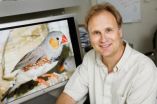(Press-News.org) An international team including University of Pennsylvania paleontologists is unearthing the appearance of ancient animals by using the world's most powerful X-rays. New research shows how trace metals in fossils can be used to determine the pigmentation patterns of creatures dead for more than a hundred million years.
The research was conducted by an international team working with Phillip Manning, an adjunct professor in the School of Arts and Sciences' Department of Earth and Environmental Science, and Peter Dodson, a professor in both the Department of Earth and Environmental Science and the School of Veterinary Medicine's Department of Animal Biology. They collaborated with Roy Wogelius of the University of Manchester, Uwe Bergmann of Stanford University's SLAC National Accelerator Laboratory and other researchers.
Their work will be published in the journal Science on July 1.
Manning and Dodson have long studied fossils of the earliest birds, including Confuciusornis sanctus, which lived 120 million years ago and was one of many evolutionary links between dinosaurs and birds, and Gansus yumenensis, which is considered the oldest modern bird and lived more than 100 million years ago. Their partnership with researchers from Manchester and Stanford, however, has opened a new avenue of investigation.
"Every once in a while we are lucky enough to discover something new, something that nobody has ever seen before," said Wogelius, a geochemist and the paper's lead author.
The team's discovery is rooted in a new technique, using technology based on synchrotron radiation to identify copper-bearing molecules in the fossilized feathers of these ancient birds.
"There is an intimate relationship between trace metals and organics. When you're getting a good suntan, melanin forms in your skin. There are many forms of melanin, and some are found in the dark feathers of birds, but copper is always bound into its structure," Manning said. "You can see this in living animals, but it's only since we've been using a synchrotron — a vast accelerator that generates intense X-rays a hundred million times brighter than the sun — that we can see the chemical detail in fossils and show that the copper complexes we found were originally part of the animal."
Metallic compounds can survive in these fossils for hundreds of millions of years because they are unpalatable to microorganisms. But to distinguish the copper that was bound in melanin with copper that might have been geochemically produced requires the precision that only a tool like the synchrotron can provide. By measuring the energy released by atoms when they are bombarded with high-powered X-rays, researchers can get an accurate picture of the molecules in which they reside.
"We're able to map absolute quantities, to parts-per-million levels in discrete biological structures, which we compare with living organisms and see they are comparable," Manning said.
The new technique paints a richer picture of the lives of these ancient creatures.
"While our work doesn't yet allow you to diagnose color, you can get the concentration and distribution of pigments," Dodson said. "In other words, you can work out monochrome patterns, which may tell us something about camouflage or other traits relevant to natural selection of the species."
"If we could eventually give colors to long extinct species, that in itself would be fantastic," said co-author Uwe Bergmann, deputy director of the Linac Coherent Lightsource at SLAC. "But synchrotron radiation has revolutionized science in many fields, most notably in molecular biology. It is very exciting to see that it is now starting to have an impact in paleontology, in a way that may have important implications in many other disciplines,"
The team is confident that further research with this technique will enable them to fully diagnose color via fossil chemistry, and they also believe that this is only one of many applications the technique will have.
"This synchrotron research is really important as it gives us the first clue to really understanding what happens with organic debris when you bury it in the ground," Manning said. "For example, there are huge implications for understanding the mass transfer of buried waste; trace metals can be bad if you get too much of them, so we can spatially map and give images of exact loadings of these metals in both living and extinct organisms. No one else can do this. It's not just contributing to a field, it's creating a whole new discipline."
###
In addition to Wogelius, Manning, Dodson and Bergmann, the research was conducted by Holly Barden, Nick Edwards and William Sellers, of Manchester University; Peter Larson of Manchester University and the Black Hills Institute of Geological Researc, Inc.; Kevin Taylor of Manchester Metropolitan University; Sam Webb of the SLAC National Accelerator Laboratory; Hai-lu You of the Chinese Academy of Geological Sciences; and Li Da-qing of the Gansu Geological Museum.
Support for this research was provided by the United Kingdom's National Environmental Research Council and an anonymous private donor.
Fossil samples were provided by the Black Hills Institute Museum and the Museum für Naturkunde, Humboldt University, Berlin. The Stanford Synchrotron Radiation Lightsource at SLAC is a Department of Energy Office of Science national user facility which provides synchrotron radiation for research in chemistry, biology, physics and materials science to more than a thousand users each year.
Penn scientists contribute to X-ray technique for determining fossil pigmentation patterns
2011-07-01
ELSE PRESS RELEASES FROM THIS DATE:
The genome guardian's dimmer switch: Regulating p53 is a matter of life or death
2011-07-01
LA JOLLA, CA— Scientists at the Salk Institute for Biological Studies have found clues to the functioning of an important damage response protein in cells. The protein, p53, can cause cells to stop dividing or even to commit suicide when they show signs of DNA damage, and it is responsible for much of the tissue destruction that follows exposure to ionizing radiation or DNA-damaging drugs such as the ones commonly used for cancer therapy. The new finding shows that a short segment on p53 is needed to fine-tune the protein's activity in blood-forming stem cells and their ...
Headwater - 6 of The Best Italian Festivals
2011-07-01
When we travel around Italy - testing our routes, talking to hoteliers, etc - we often come across things we never previously knew about! So, we thought it only fair to share some of our favourite findings with you!
Emilia Romagna: Festa di San Cassiano
Plan your cycling holiday so that you'll be in Comacchio on 13th August 2011 and join the locals in celebrating the feast of their Patron Saint, San Cassiano.
Known affectionately as "Little Venice", postcard-pretty Comacchio is a maze of canals and bridges rising out of 13 different islands and islets. ...
Thanks for the memories
2011-07-01
How easy is it to falsify memory? New research at the Weizmann Institute shows that a bit of social pressure may be all that is needed. The study, which appears Friday in Science, reveals a unique pattern of brain activity when false memories are formed – one that hints at a surprising connection between our social selves and memory.
The experiment, conducted by Prof. Yadin Dudai and research student Micah Edelson of the Institute's Neurobiology Department with Prof. Raymond Dolan and Dr. Tali Sharot of University College London, took place in four stages. In the first, ...
Potential of simple injection on patients with head injury
2011-07-01
The study involved 270 adult trauma patients with, or at risk of, significant extracranial bleeding within 8 hours of injury, who also had traumatic brain injury. It was a prospective randomised controlled trial carried out within the larger CRASH-2 trial to quantify the effect of an early short course of tranexamic acid on intracranial haemorrhage.
In May 2011, the CRASH-2 trial collaborators' paper: Effects of tranexamic acid on death, vascular occlusive events, and blood transfusion in trauma patients with significant haemorrhage (CRASH-2): a randomised, placebo-controlled ...
Using fear to guide smart investments
2011-07-01
Tel Aviv — Playing the stock market can be a risky game. And when the market behaves unpredictably, public fear can lead to erratic investment responses and market chaos.
But there is a way to make this fear work in your favor, say Prof. Eshel Ben-Jacob and Dr. Yoash Shapira of Tel Aviv University's Raymond and Beverly Sackler School of Physics and Astronomy. The team's recent research demonstrates that a smart stock market portfolio should not only take into account negative correlations on returns among the stocks, but also the dynamics of volatility. "It's a way to ...
MicroRNAs in the songbird brain respond to new songs
2011-07-01
CHAMPAIGN, Ill. — Whenever it hears an unfamiliar song from a bird of the same species, a zebra finch stops chirping, hopping and grooming. It listens attentively for minutes at a time, occasionally cocking its head but otherwise immobile. Once it becomes familiar with the song, it goes back to its busy routine. (See video.)
In a new study, researchers discovered that levels of microRNAs – short lengths of ribonucleic acid that appear to regulate protein production – go up or down in the songbird brain after it hears a new song. These microRNAs likely represent a new ...
Headwater's Top 10 Spring Gardens
2011-07-01
Knowing how many of you are keen gardeners, and with the prestigious Chelsea Flower Show opening this week, we've decided to share our top 10 garden choices for summer 2011.
1. The beautiful park surrounding the Chateau de Chenonceau in France's Loire Valley hosts the International Garden Festival annually between May and October. It's a fabulous fusion of 'conceptual' gardens created by green-fingered artists and, bizarrely, philosophers! Visit on our Chateaux of the Loire Cycling holiday
2. Majorelle Gardens: designed in 1924 by French expatriate artist, Jacques ...
Researchers predict locations for deer vs. car collisions
2011-07-01
University of Alberta researchers have produced a map of Edmonton predicting the most likely locations where vehicles will collide with deer. These collisions can be fatal for drivers and their passengers. The hot spots for deer vs. vehicle collisions virtually encircle Edmonton along the city limit, border line.
Mark Boyce is a U of A ecologist and co author of the paper. Boyce found that the most dangerous rural roadways share three features; Natural vegetation, bushes and trees, run right up to the roadside, the roads pass through a landscape of farm fields and forests ...
Nervous system stem cells can replace themselves, give rise to variety of cell types, even amplify
2011-07-01
A Johns Hopkins team has discovered in young adult mice that a lone brain stem cell is capable not only of replacing itself and giving rise to specialized neurons and glia – important types of brain cells – but also of taking a wholly unexpected path: generating two new brain stem cells.
A report on their study appears June 24 in Cell.
Although it was known that the brain has the capacity to generate both neurons, which send and receive signals, and the glial cells that surround them, it was unclear whether these various cell types came from a single source. In addition ...
Variation in make-up of generic epilepsy drugs can lead to dosing problems
2011-07-01
Generic anti-epilepsy drugs, pharmaceutical products similar to brand-name versions, save consumers billions of dollars each year, but some are different enough from branded formulations that they may not be effective, particularly if patients switch between two generic drugs, a new study by Johns Hopkins researchers suggests.
A report on the study, published online and in an upcoming issue of Annals of Neurology, raises questions about whether some generic products are safe and effective when a narrow dose range separates patients from help and harm.
"In most areas ...




